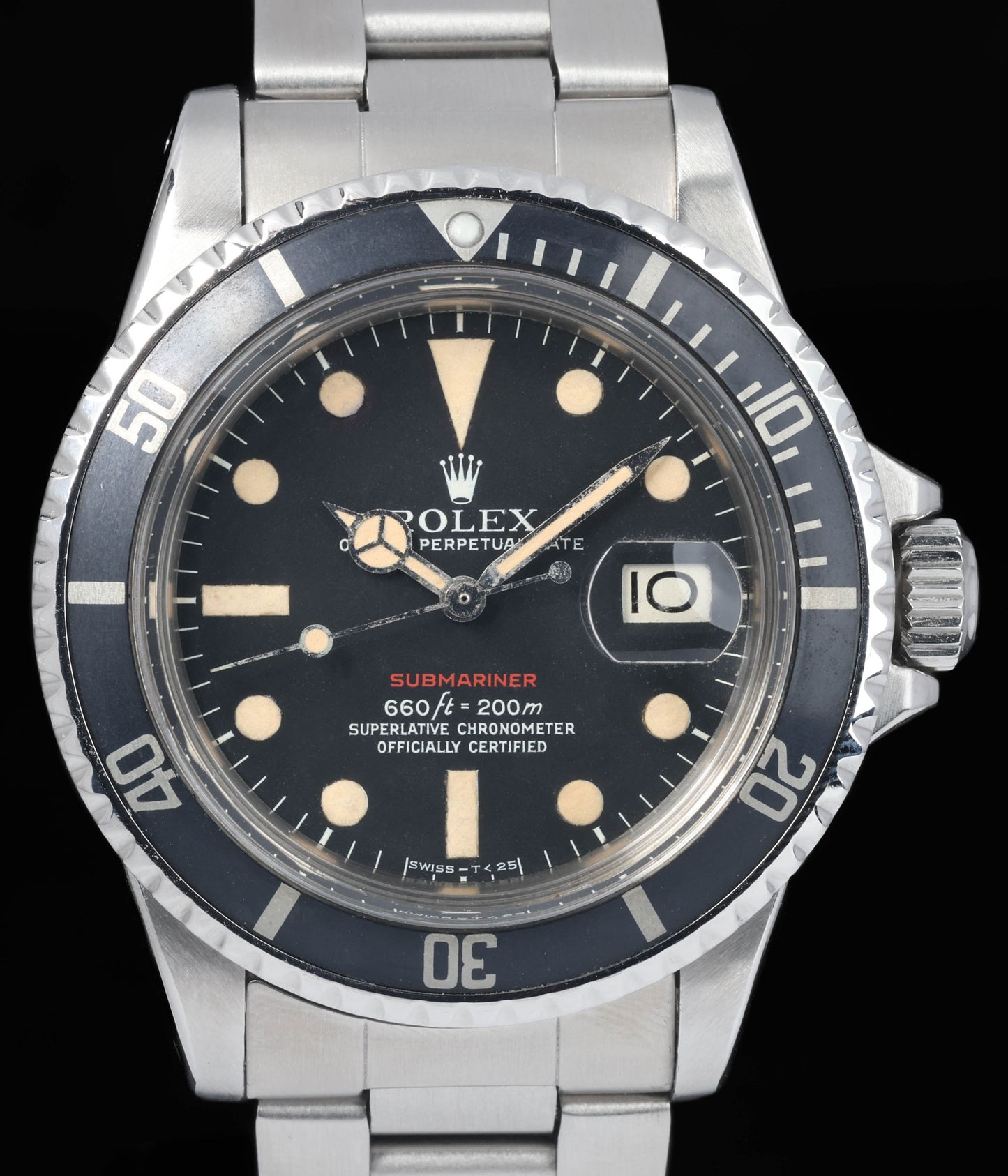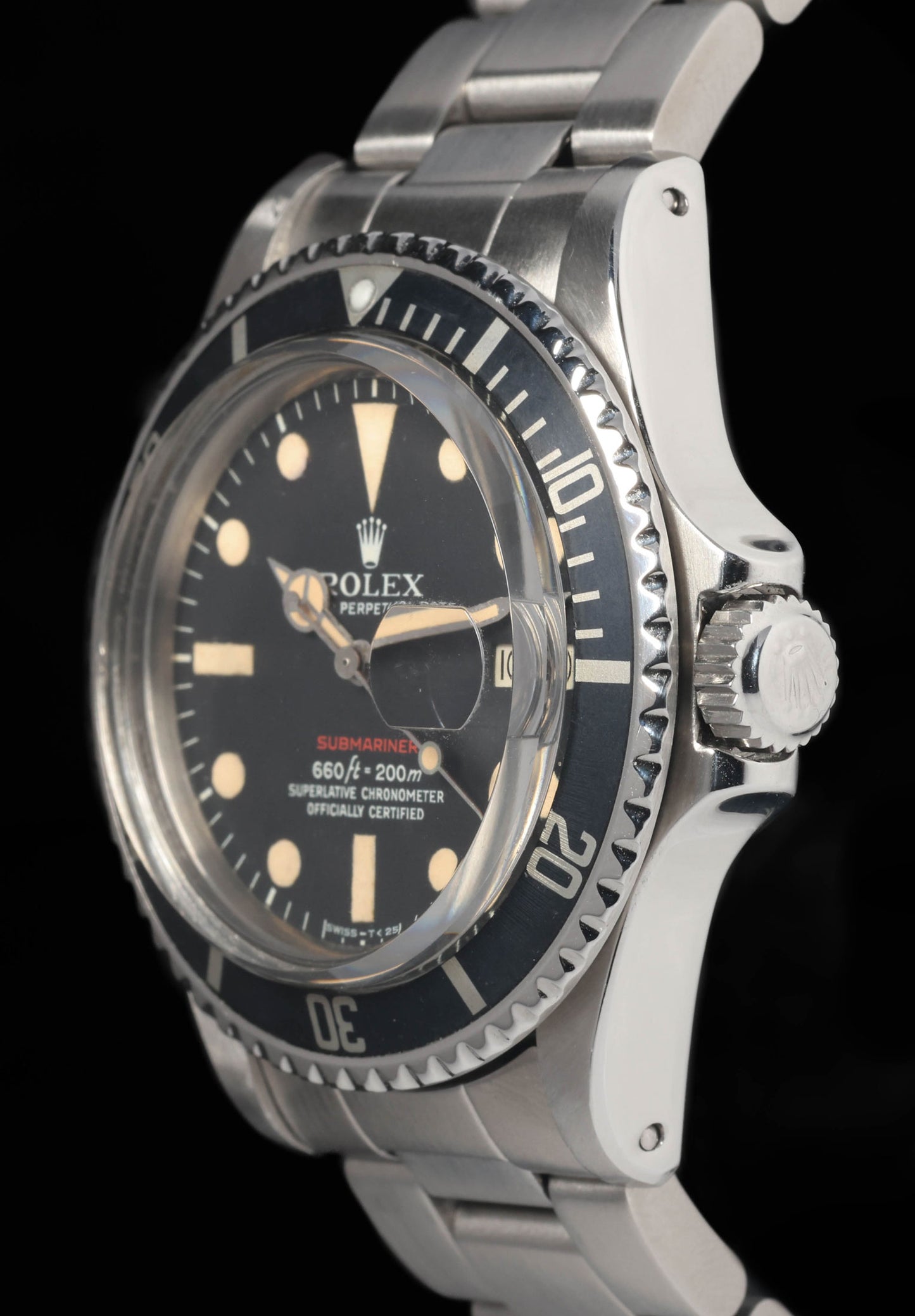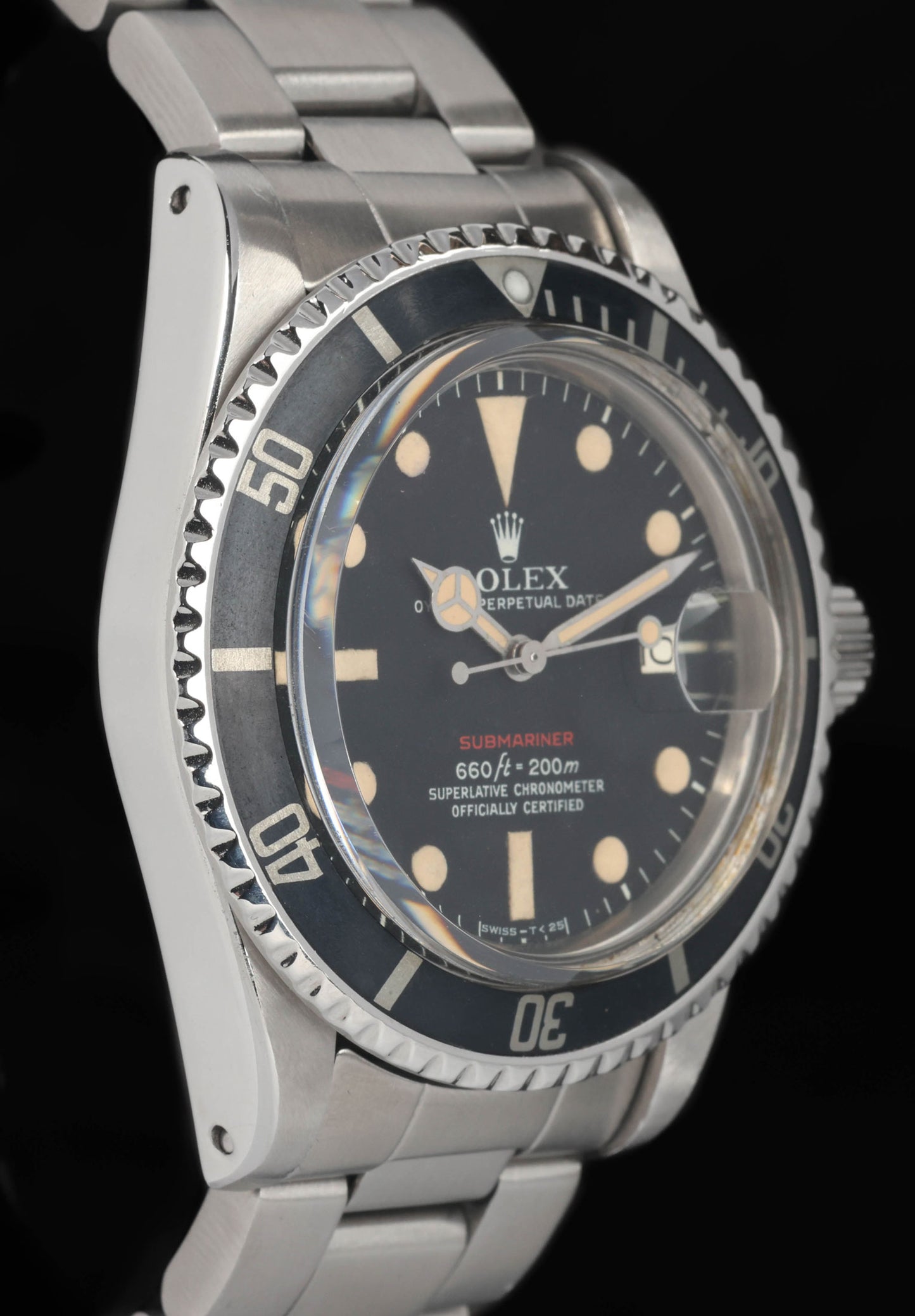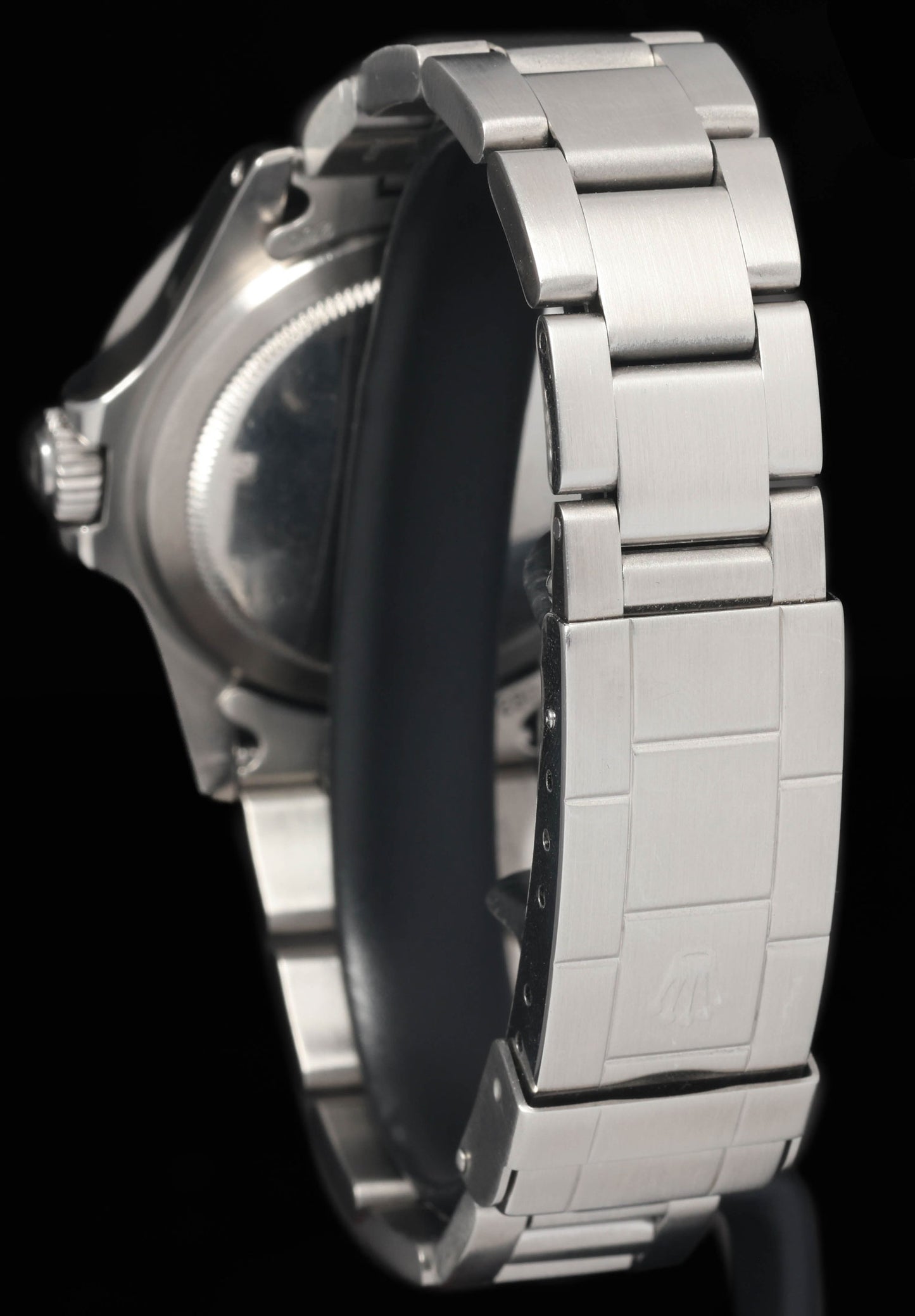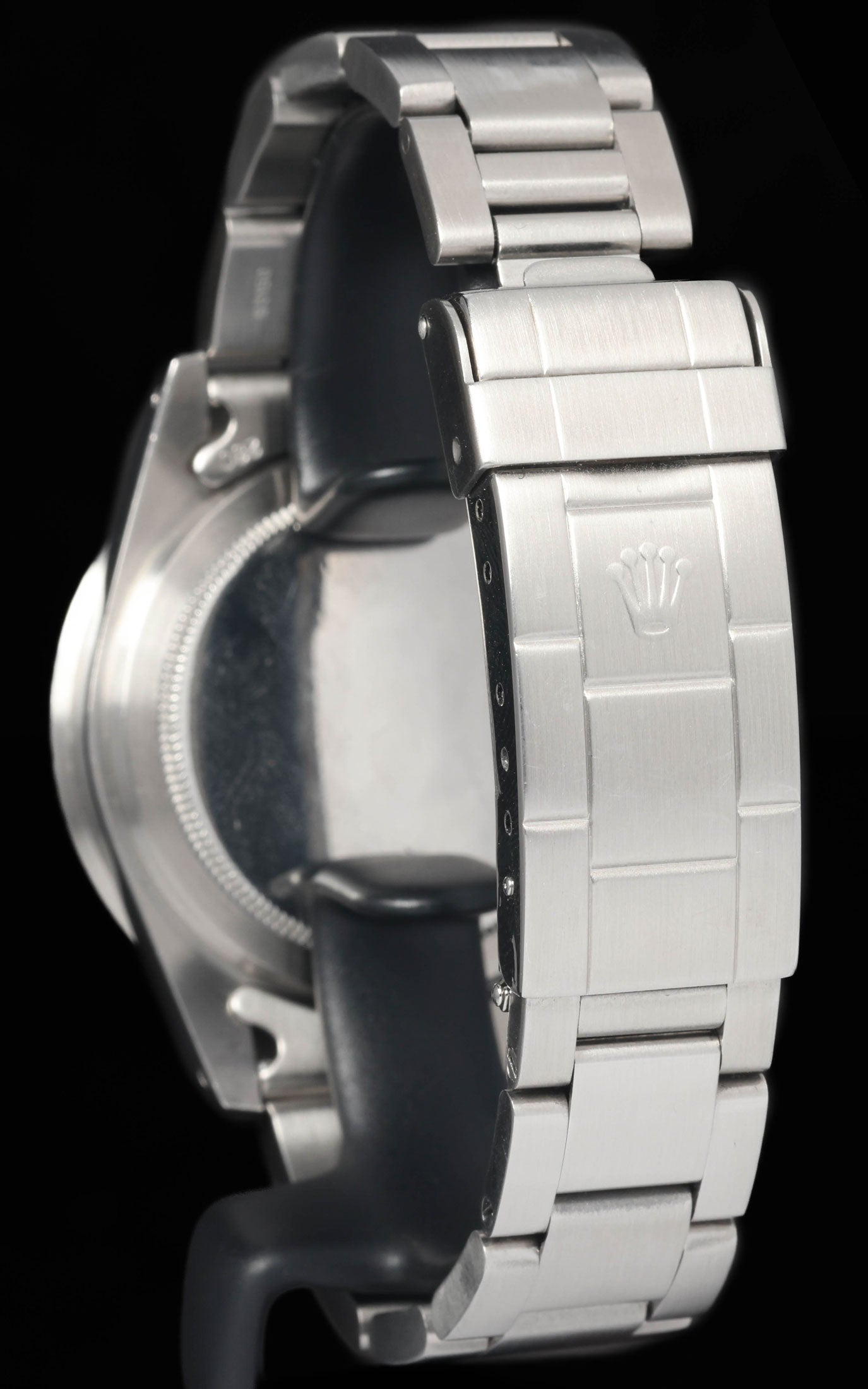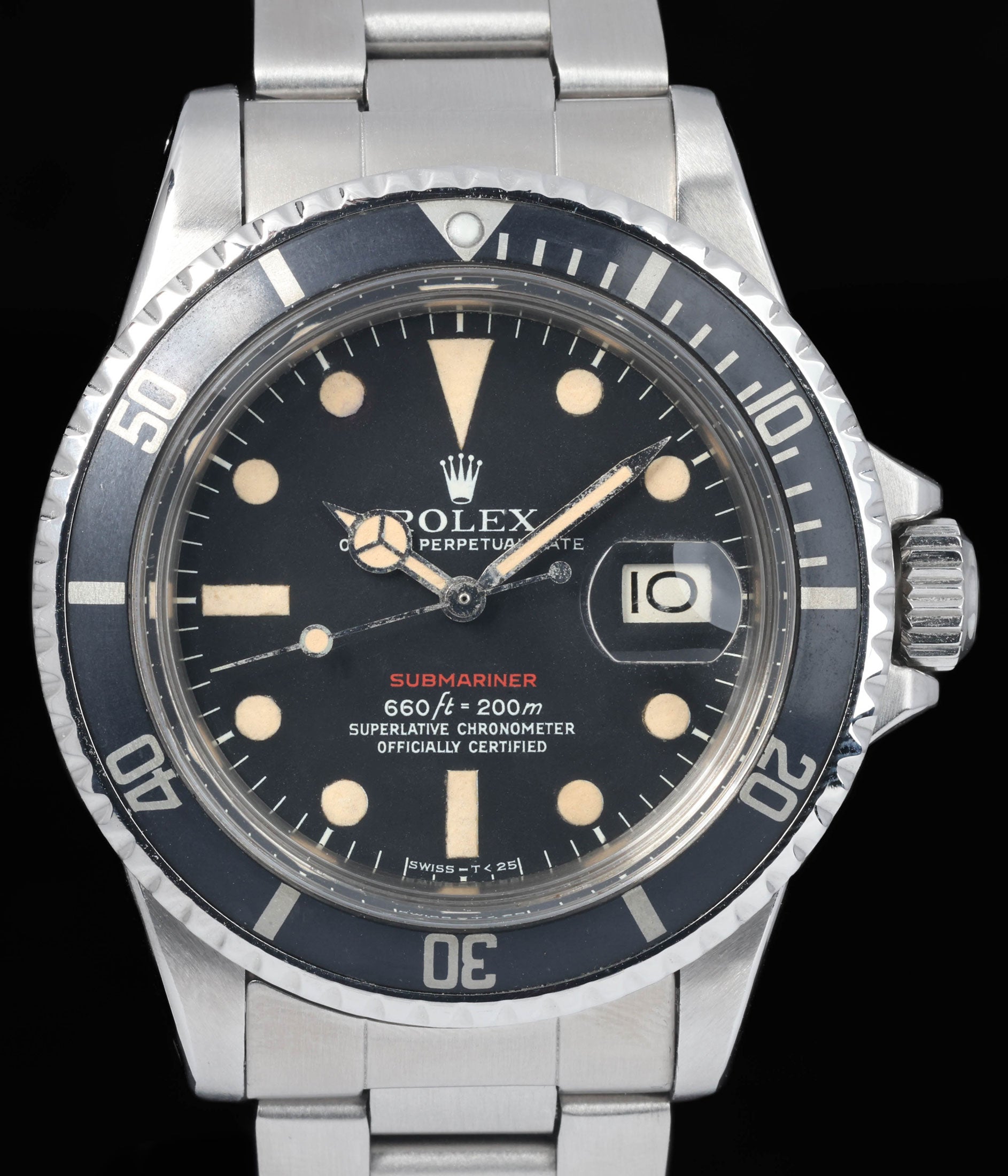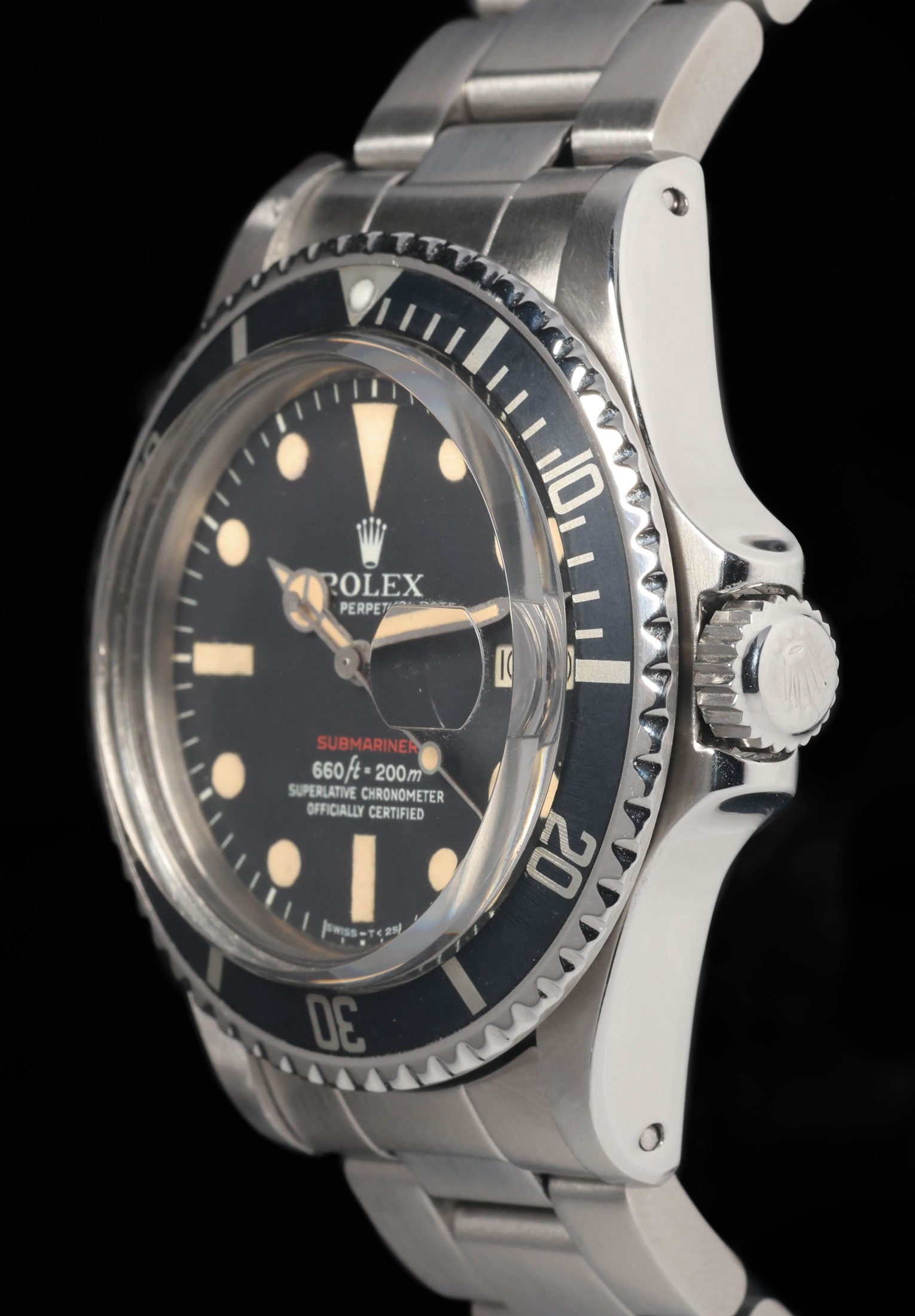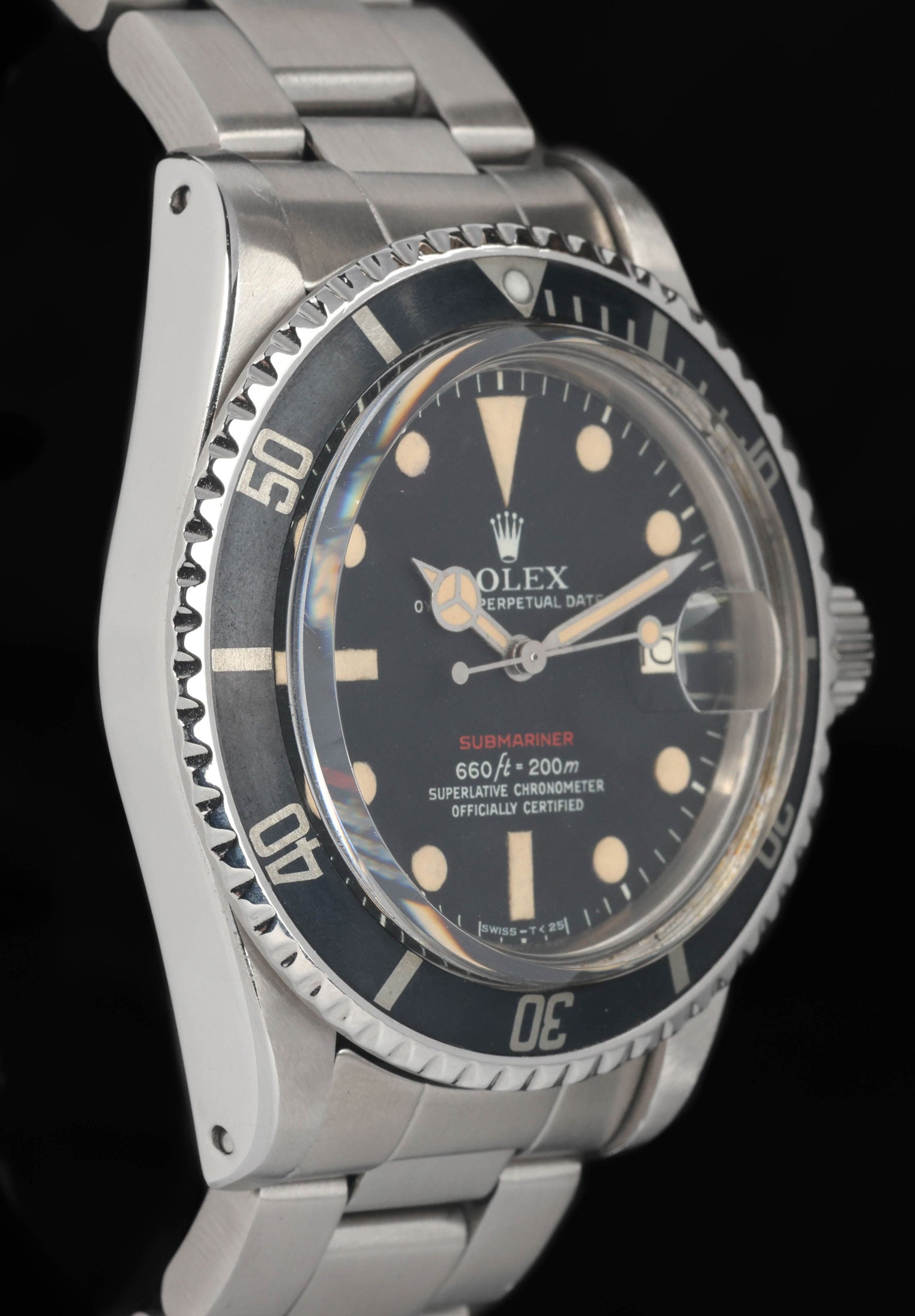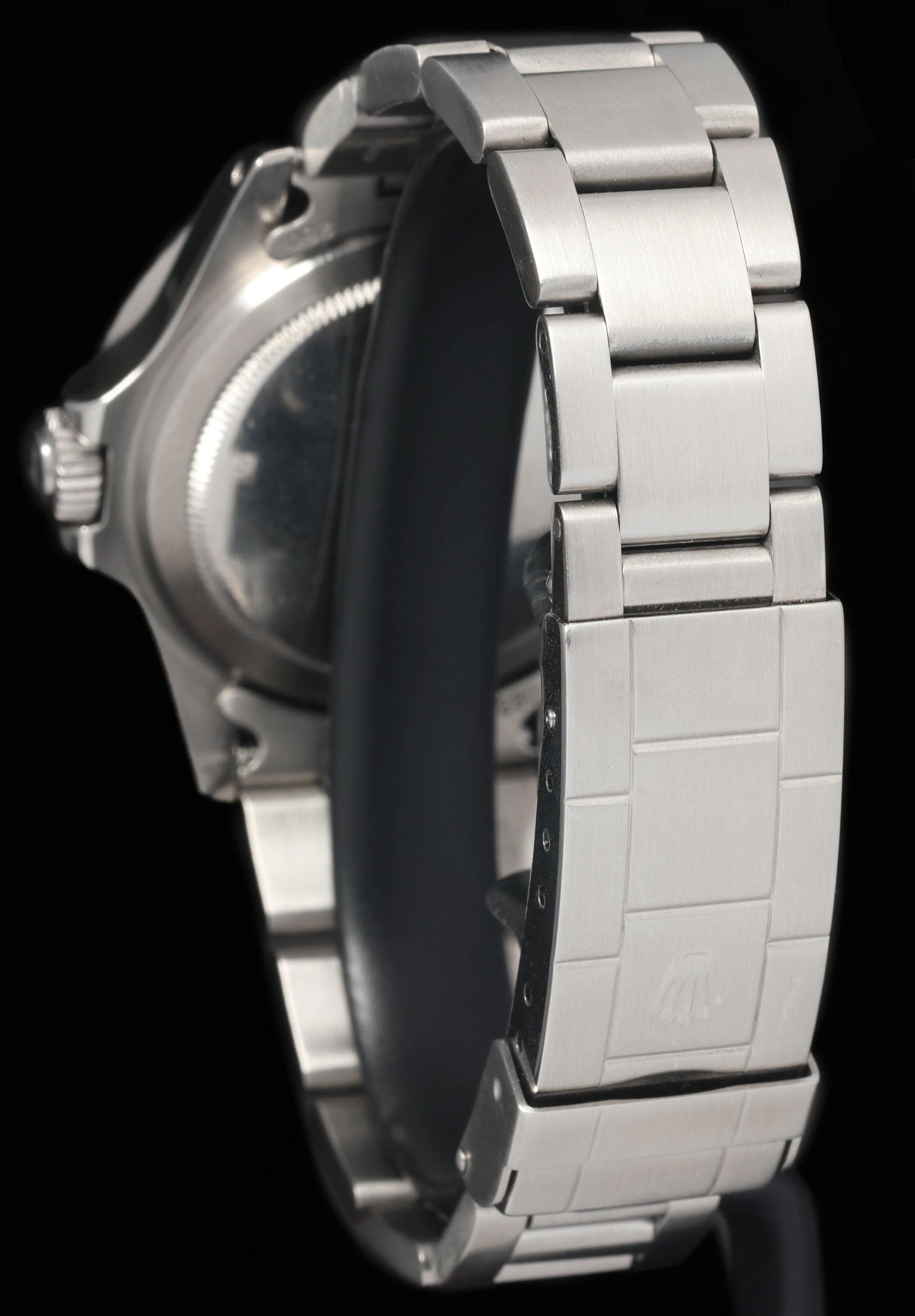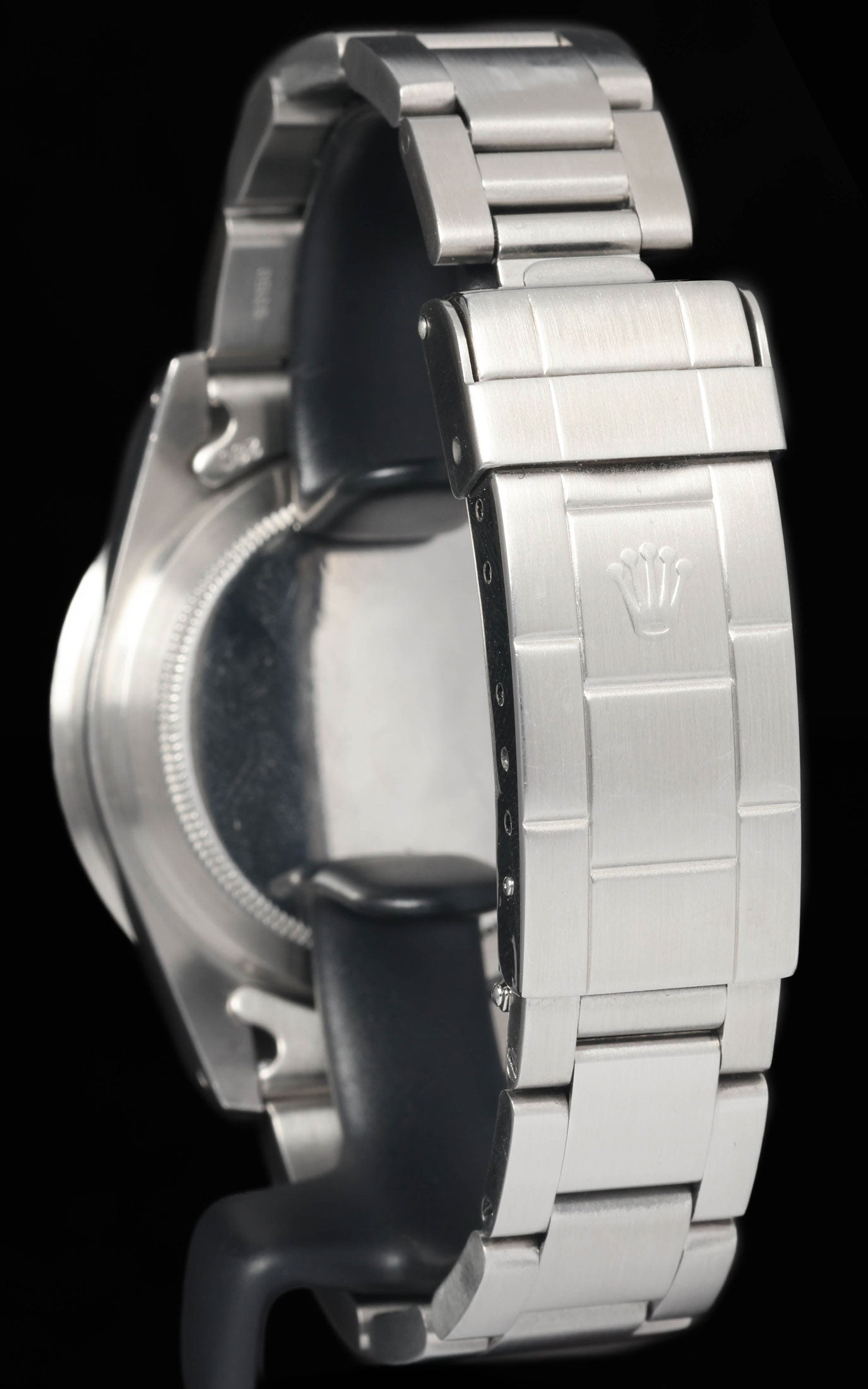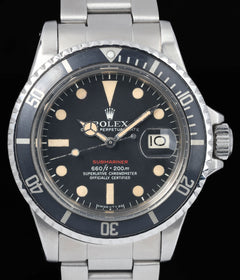Crown Vintage
Rolex Submariner 1680 ‘Red’ Mark 5 Dial 40mm 1972
Rolex Submariner 1680 ‘Red’ Mark 5 Dial 40mm 1972
Couldn't load pickup availability
Rolex Submariner 1680 ‘Red’ Mark 5 Dial 40mm 1972
This Rolex Submariner 1680 ‘Red’ Mark 5 Dial 40mm from 1972 is in very good vintage condition. The stainless steel case shows light hairlines throughout, consistent with gentle wear over time, while retaining its solid proportions and defined edges. The watch is fitted with a later Rolex 93150 Oyster bracelet, a correct service replacement that complements the case well. The original Mark 5 dial has been professionally restored and presents in great condition, retaining the signature red ‘Submariner’ text that defines this reference. The tritium hour plots show pleasing even tones, harmonising beautifully with the ivory patina on the matching Mercedes-style hands. The bezel insert, crystal, and crown complete the watch’s authentic vintage presentation. As with all timepieces of this era, it should be regarded as a vintage watch and not worn for swimming, even though the Submariner was originally designed as a professional dive watch.
Share
Why we love this watch
Why we love this watch
Rolex Submariner 1680 ‘Red’ 1972 Mark 5 Dial
Introduction
Produced through the late 1960s and 1970s, it was the first Submariner to feature a date function, introducing the signature Cyclops magnifier to the model line. What makes certain early examples particularly sought after, however, is a small detail on the dial - the word “Submariner” printed in red. This red line, present only on early production runs, set the “Red Submariner” apart and has since become a defining visual hallmark of this period.
The Evolution of the Submariner to the 1680
The Rolex Submariner’s story began in 1953, marking the brand’s formal entry into the professional diver’s market. The early references, such as the 6204 and 6205, offered minimal water resistance and lacked the depth rating precision seen in later pieces. The introduction of the reference 5512 in 1959 refined the case design and introduced crown guards, followed shortly by the 5513, which carried the model through much of the 1960s. By the end of that decade, Rolex recognised the commercial potential in merging the Submariner’s utilitarian design with the everyday convenience of a date display. This led to the introduction of the reference 1680 around 1969.
In functional terms, the 1680 represented a significant shift. It brought the Submariner line into alignment with the broader Oyster Perpetual Date range, while also positioning it closer to the emerging concept of the “luxury tool watch.” The inclusion of the date function, magnified by the Cyclops lens, changed the dial balance but also made the model more practical for daily use. This hybrid approach reflected Rolex’s growing understanding of its audience - professionals and adventurers, yes, but also those seeking a reliable and stylish everyday watch.
The ‘Red’ Submariner Era
When the 1680 first appeared, the earliest dials bore the word “Submariner” in red text. This subtle detail appeared across several dial variations, now referred to by collectors as Mark I through Mark VI. The red print was eventually phased out by the mid-1970s, replaced entirely by white text as Rolex standardised its production. While variations exist across fonts, spacing, and alignment, the core visual identity of the “Red Submariner” remains consistent: the vibrant red line breaking the otherwise monochrome dial.
Our example from 1972 features what is categorised as a Mark 5 dial. This type was among the later iterations of the red print, displaying a more standardised layout. It retained the “660ft = 200m” and exhibited a more even serif typeface than earlier variants. By this stage, Rolex’s dial suppliers had refined production consistency, meaning the Mark 5 represents a period when the model’s aesthetics had matured before the transition to the all-white text dials.
Technical Characteristics
The Submariner 1680 was powered by Rolex’s calibre 1575, a robust automatic movement that succeeded the calibre 1570 used in earlier models. It featured a date complication and a quick-set hacking seconds function, introduced in later production. Known for its reliability and stability, the 1575 operated at 19,800 vibrations per hour and featured a Breguet overcoil hairspring and a free-sprung balance regulated by Microstella screws. Its performance characteristics helped cement Rolex’s reputation for precision, even under the most challenging conditions.
The 1680 maintained the traditional stainless steel Oyster case, measuring 40mm across, and offered a depth rating of 200 metres (660 feet). Though this was slightly less than some competing dive watches of the era, Rolex’s conservative approach to specifications reflected its focus on consistent reliability rather than exaggerated claims..
The bezel, with its bidirectional aluminium insert, featured minute graduations for the first 15 minutes - a functional design cue for decompression timing. Over decades of use, many of these bezels often aged into distinctive “ghost” hues of grey or blue, giving many examples a unique character today. The crystal was acrylic, another hallmark of the period, offering both durability and ease of replacement compared to later sapphire versions.
The Bracelet and Case Construction
By 1972, the Submariner 1680 was paired with the 9315 folded-link Oyster bracelet, secured with a 280 end link fitting. This bracelet was lighter and more flexible than the later solid-link 93150 type introduced later in the decade. The clasp bore the Rolex coronet logo and a flip-lock safety clasp - a design detail that reinforced the model’s tool-watch functionality.
The case profile of the 1680 was more substantial than earlier references, accommodating the added height of the date wheel and crystal. The sidewalls appeared thicker, and the crown guards more pronounced than those of the 5513. The caseback retained the “Rolex Oyster” engraving, and examples from the period often show a 2.9 to 3.4 million serial range, consistent with early 1970s production.
Dial and Hands
The Mark 5 dial on this example retains the matte finish typical of the era, with tritium luminous plots at each hour marker. By 1972, Rolex had perfected its use of tritium as a luminous material, balancing legibility and safety compared to the earlier radium applications of the 1950s. Over time, these tritium plots often age into warm tones of cream or yellow, a feature highly valued for its natural patina.
The Mercedes-style hands, also tritium-filled, match the dial lume tone. The date wheel displays an open 6 and 9 font, a detail consistent with period-correct examples. At 3 o’clock, the Cyclops lens magnifies the date, becoming one of the most recognisable features of the Submariner from this generation onwards.
Although much has been written about the different “Marks” of red printing, the key fact remains that the Mark 5 represents a late but still original phase of red-text dials before the switch to all-white lettering. It captures the tail end of the “Red Sub” production, bridging the aesthetic link between the vintage and later Submariner models.
Production Context and Transition
By the early 1970s, Rolex was steadily modernising its manufacturing approach. The brand was moving toward greater component standardisation and automated dial production. The 1680’s lifespan therefore coincided with an industrial turning point for Rolex - from smaller-scale assembly to a more controlled, internally consistent process.
This transition period also saw Rolex introduce the Sea-Dweller 1665 as its professional deep-diving counterpart, offering helium escape functionality. The 1680, though not equipped for saturation diving, remained the brand’s core commercial diver. The distinction between the two models highlights Rolex’s dual approach during this period: one focused on absolute depth performance, the other on robust daily usability.
As the decade progressed, Rolex gradually replaced the red print with white, simplifying production and aligning the Submariner visually with the rest of its Oyster line. The earliest white-text 1680s appeared around 1975, marking the end of the “Red Submariner” era.
The Historical Importance of the 1680
The 1680 occupies a unique position in Rolex’s timeline. It was the first Submariner to incorporate a date function — a change that would influence every future generation of the Submariner Date series. Its design elements, including the Cyclops lens, matte dial, and acrylic crystal, are emblematic of Rolex’s 1970s aesthetic, while its underlying movement technology represented the culmination of the brand’s mid-century mechanical development.
From a historical standpoint, the 1680 stands at the crossroads between the utilitarian watches of the 1960s and the luxury sports models that defined the brand’s later decades. Its use by professional divers, naval personnel, and adventurers reinforces its credibility as a tool watch, yet it also became a status symbol in urban and business settings. This dual identity continues to shape the Submariner’s modern appeal.
In addition, the 1680’s red lettering has come to symbolise the last truly distinctive visual cue before the model line adopted the more corporate aesthetic of the late 1970s. That small touch of red, while initially unremarkable, now represents the transitional era when Rolex began to balance form and function with brand identity.
Case Study: A 1972 Example
This 1972 reference 1680 with a Mark 5 dial falls within the 3 million serial range. These examples display a uniform set of features, including the folded-link bracelet, tripartite case structure, and matte tritium dial. The engraving between the lugs reads “1680” at 12 o’clock and the serial number at 6 o’clock, consistent with Rolex’s production layout of the era.
The case proportions of this reference maintain a symmetrical balance between robustness and wearability. Measuring 40mm across and roughly 13.5mm thick, it wears slightly taller than its no-date sibling due to the date wheel assembly and acrylic crystal. The lug width remains 20mm, compatible with standard Oyster bracelets and NATO straps.
Design Legacy
The reference 1680’s influence extends well beyond its own production years. Modern Submariners, including the current references in steel and gold, continue to trace their lineage directly to this model. The addition of the date and the Cyclops magnifier became permanent design elements of the Submariner Date line.
The matte dials of the 1680 also set the tone for Rolex’s tool-watch era, a period that prioritised legibility and functional minimalism. Later glossy dials with white-gold surrounds, introduced in the 1980s, reflected changing tastes but built upon the strong visual identity established by watches like the 1680.
Even today, the 1680 remains one of the clearest expressions of Rolex’s design evolution — bridging the early hand-finished aesthetic with the modern industrial precision the brand is known for. The use of red print, acrylic crystal, and folded bracelet marks it as distinctly 1970s, while the proportions and mechanical reliability remain timeless.
The Broader 1970s Context
During the early 1970s, Rolex was solidifying its place in the market against growing competition from both mechanical and, increasingly, quartz timepieces. The 1680’s release occurred during a decade defined by rapid technological change in the watch industry. The emergence of quartz technology posed an existential challenge to traditional mechanical brands.
Yet, Rolex held firm in its commitment to mechanical excellence and durability. Rather than pursue quartz dominance, Rolex doubled down on refining the quality and accuracy of its automatic calibres. The 1680 therefore represents Rolex’s confidence in its own mechanical engineering at a time when others were abandoning it.
Culturally, the 1970s also marked the point where watches began to cross over from professional tools to lifestyle accessories. The Submariner 1680’s popularity among sportsmen, explorers, and public figures helped broaden its appeal beyond diving circles. Its clean, functional aesthetic aligned well with the era’s understated style, making it as suitable for boardrooms as for open water.
Wearability and Functionality
The Submariner 1680 remains a highly wearable watch even by contemporary standards. Its 40mm case sits comfortably on most wrists, balanced by the lightness of the folded-link bracelet. The acrylic crystal provides a warm distortion around the edges, adding a characterful softness absent from later sapphire models. The rotating bezel remains tactile and purposeful, with 60-minute graduations providing easy timing reference.
The luminous material, though aged, still retains enough glow when briefly charged, serving as a reminder of Rolex’s precision in its material science even half a century ago. While originally rated to 200 metres, vintage examples like this 1972 Mark 5 should be treated as historical timepieces rather than modern dive instruments. Their seals and materials are not designed for present-day immersion use, and preservation should take precedence over functionality.
Final Thoughts
The Rolex Submariner 1680 ‘Red’ represents one of the most meaningful milestones in the brand’s evolution. It introduced the date complication to the Submariner line, redefined the model’s position between professional tool and refined everyday watch, and carried forward the technical excellence that underpins every Rolex diver that followed.
This 1972 example with its Mark 5 dial stands as a testament to the model’s maturity during the early 1970s — a period when Rolex’s manufacturing processes, design language, and brand confidence all converged. The combination of the red “Submariner” text, matte tritium dial, acrylic crystal, and folded Oyster bracelet defines an era that remains instantly recognisable and deeply significant within Rolex’s history.
Case & Bracelet
Case & Bracelet
- Case in very good vintage condition, light hairlines visible throughout.
- Bracelet 93150 service replacement
Dial & Hands
Dial & Hands
- Dial original restored mark 5 dial in great condition
- Hands ivory patina matching dial
Warranty & Condition
Warranty & Condition
Crown Vintage Watches provides a minimum 3-month mechanical warranty on pre-owned watches, from the date of purchase.
The warranty covers mechanical defects only.
The warranty does not cover damages such as scratches, finish, crystals, glass, straps (leather, fabric or rubber damage due to wear and tear), damage resulting from wear under conditions exceeding the watch manufacturer’s water resistance limitations, and damage due to physical and or accidental abuse.
Please note, water resistance is neither tested nor guaranteed.
Shipping and insurance costs for warranty returns to us must be covered by the customer. Returns must be shipped via traceable courier. Return shipment must be pre-paid and fully insured. Collect shipping will be refused. In case of loss or damages, the customer is liable.
Our Pledge
At Crown Vintage Watches, we stand by the authenticity of every product we sell. For added peace of mind, customers are welcome to have items independently authenticated at their own expense.
Condition
Due to the nature of vintage timepieces, all watches are sold as is. We will accurately describe the current condition and working order of all watches we sell to the best of our ability.
Shipping & Refund
Shipping & Refund
